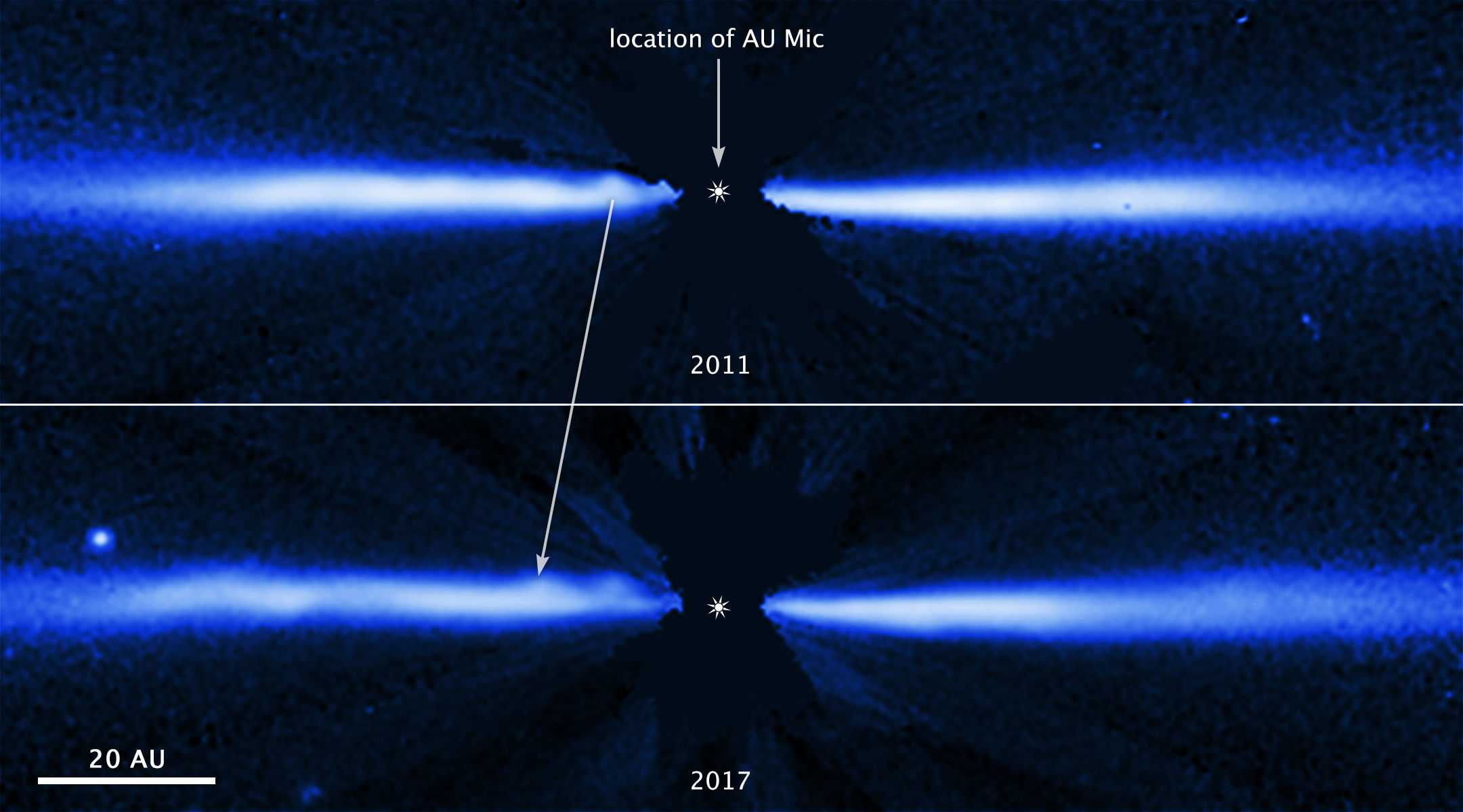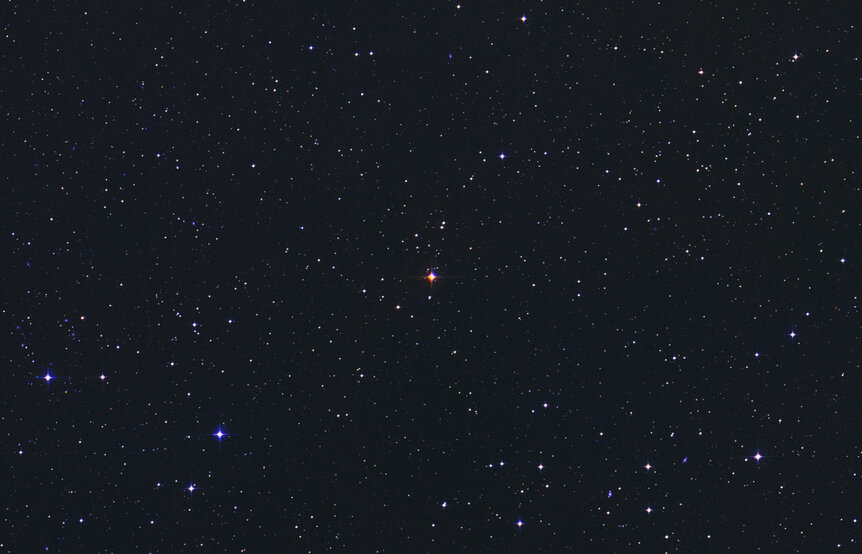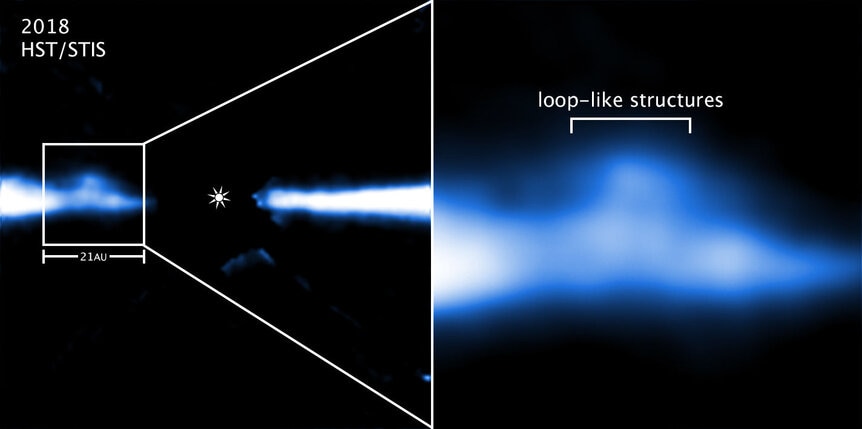Create a free profile to get unlimited access to exclusive videos, sweepstakes, and more!
Rocky worlds around red dwarfs may get blasted clean of water

New observations of a young, nearby red dwarf star indicate that any planets forming there may get scoured clean of water and other materials before they even get a chance to cool down after forming. If this is the case, it implies that life on these kinds of planets may be more rare than we first thought. Given that planets around red dwarfs are probably the most common in the Universe, this news, well, kinda sucks.
The star in question is AU Mic — short for AU Microscopii — a red dwarf about 32 light years away (so, pretty close as stars go). It's faint, cool, and small, as red dwarfs are, but it's also young: about 23 million years old. It still has a debris disk circling it, a vast flat LP of material orbiting it, made up of bits of gas and dust and other things left over from the formation process. This is the stuff from which planets form.
We know of many red dwarf stars with planets, including TRAPPIST-1, a star with at least seven (!) roughly Earth-sized rocky planets orbiting it. It seems planets form easily around such small stars, which is neat, but even cooler is that these are by far the most numerous kinds of stars in the Universe. As many as ¾ of all stars may be red dwarfs.
That makes it pretty important to understand how these planets form. Conditions around such a low-mass star are different than they were around the Sun back in the day, or around an even more massive and hotter star. Happily, AU Mic is close enough to get some good details on the disk.
As it happens, we see AU Mic's disk almost (but not quite) exactly edge-on, so from Earth it appears as a thick line going out in either direction from the star. If the star itself can be blocked out, faint details in the disk can be seen (think of it as holding your hand up to block the Sun so you can see a plane flying near it in the sky). Astronomers have observed AU Mic and its disk using various telescopes and detectors equipped with coronagraphs, small pieces of metal designed to block the glaring starlight, for years.
That timescale turns out to be important. Over those years, the disk has changed. See for yourself:
The images were taken with STIS, a camera on board Hubble (personal note: I worked on STIS before and after launch, and I love being able to write about it; in fact I worked with several of the people who worked on these AU Mic observations). The top image was taken in 2011, and the bottom in 2017 (the position of AU Mic is marked in the center, and the star in the bottom image on the left is a background star; it's not in the top image because AU Mic moves across the sky relatively rapidly and in between images got closer to the position of that star in the sky).
There's a blob of material in the top image that has clearly moved away from the star over the six years between observations. Knowing the distance to AU Mic and how far it moved, that blob has been clocked at a speed of at least 7 kilometers per second (and possibly more, depending on the actual direction it's moving). Many such blobs have been seen in the disk, some moving nearly twice that fast!
The European Space Agency put together a short video a few years back using data from STIS and a super-high-resolution camera called SPHERE that puts these blobs in motion:
It's not clear what's accelerating these blobs. As is common with young red dwarfs, the star is pretty active magnetically, blasting out flares of energy that sometimes dwarf the kind we see on the Sun. It's likely this is tied somehow to the engine behind the blobs, but it's not clear at this time.
One effect of these blobs sweeping across the disk is that they push on smaller dust grains, blowing them outward, away from the star. This may also include water molecules and other volatiles (compounds with low boiling points, like carbon dioxide and ammonia). Given the speed and size of these blobs, they may be in the process of sweeping all this material away from the disk.
That's bad. Planets forming close to the star may have some water intrinsic to them, but a lot is supplied later by asteroid and comet impacts — these can form farther out, where water ice is more abundant in the disk. But if the blobs remove that material, it could mean the planets left behind are high and dry.
And it may happen rapidly. Given the size and density of the blobs, the astronomers estimate they could dissipate the disk in as little as 1.5 million years. That's really fast. Once these planets cool down after formation, they may very well be deserts.
That's a bummer. What's worse is that AU Mic may be a typical example of a young red dwarf star. Given how vast our galaxy is, it would be weird if it represents an extreme case when it's so close to us; you'd expect rare objects to be, on average, much farther away. So if most red dwarfs behave this way when they're young, this observation implies red dwarf planets may be severely deficient in water.
Well, nuts. I don't want to extrapolate too much here, but this does throw a dry blanket on the idea that life may be everywhere in the galaxy. These kinds of planets may outnumber all the others by a large amount. That may make life, or at least life like us, rare.
Of course, life may be able to get a pseudopod hold without water. We don't have too many examples, so it's hard to say. Again, extrapolating too far would be unwise.
So, the thing to do is to keep looking. Keep observing stars, all kinds of stars at all different ages and places and chemical compositions and temperatures, keep looking for and at their planets, and see what's what. I'm still hoping that the sheer number of planets in the galaxy — perhaps trillions — may make up for the small fraction that may be suitable for life.
A trillion times even a reasonably small number is still a lot. We'll see. Eventually.





























